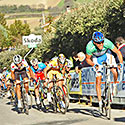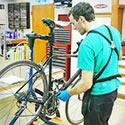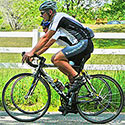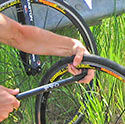Getting Into Bicycle Racing: Preparation
 Nothing's better than spinning along smooth pavement and cruising sweet singletrack with good friends. But, have you ever noticed when cresting a hill, or approaching a city-limits sign, that you have an irresistible urge to be the first one to get there? That you can't help but pick up the pace? And that, as your friends respond, a burst of adrenaline feeds your need to lead? That’s racing!
Nothing's better than spinning along smooth pavement and cruising sweet singletrack with good friends. But, have you ever noticed when cresting a hill, or approaching a city-limits sign, that you have an irresistible urge to be the first one to get there? That you can't help but pick up the pace? And that, as your friends respond, a burst of adrenaline feeds your need to lead? That’s racing!
That intensity and excitement of pushing just a bit harder is what bicycle racing is all about. To help you get off on the right pedal in this great sport, we've put together this guide. Who knows? It might help you become the next Lance Armstrong?
Tune up Your Bicycle
For safe and efficient racing, your bicycle must be in excellent working order. It should shift and brake perfectly. The tires should be new or nearly new. And, all the parts should be tight, properly adjusted and lubricated.  This is important because racing tests bikes and you don't want to get knocked out of a race due to a mechanical. If you’re not handy with bike repair, bring your rig to our shop for a tune-up. Let us know you’re entering your first race and we’ll get your machine ready to rock! Or, if your bike's really old and dilapidated, treat yourself to a new one. We've got a great selection of race-ready rigs with all the latest features. Come in for a test ride to feel the difference these thoroughbreds make.
This is important because racing tests bikes and you don't want to get knocked out of a race due to a mechanical. If you’re not handy with bike repair, bring your rig to our shop for a tune-up. Let us know you’re entering your first race and we’ll get your machine ready to rock! Or, if your bike's really old and dilapidated, treat yourself to a new one. We've got a great selection of race-ready rigs with all the latest features. Come in for a test ride to feel the difference these thoroughbreds make.
Tune Up Your Body
Now that your bike's dialed, it’s time to tune up the motor. If you’ve been sitting on the couch all winter watching reruns, chances are you’re not ready to race. Put down the potato chips and hop on your bike! Get at least four weeks of riding in your legs before entering your first race. You don't need to ride every day. But you want some miles in your legs in order to make your first race experience a pleasant one. If you’re racing in a beginner class, chances are the event won’t exceed two hours. But, make sure that at least one ride a week is 10% longer than race distance, so you’ll feel confident about finishing.
| Type of Racing | Website |
| Road/Mountain/ Track/Cyclocross/ BMX |
USA Cycling |
| Road/Mountain | Prerace |
| Mountain | MTB Race News |
| Endurance Mountain | Ride 424 |
| Road/Mountain (Colorado) | American Cycling |
| Road (Midwest) | AM Bike Race |
| More | Sportsbase, BikeReg |
Find Races
We can tell you about the popular events in our area. If we're closed, your best source of race information is online. We've listed a number of helpful resources here. You may also find listings in your local newspapers or the free regional magazine, Competitor, which has an events calendar organized by location to make it easy to find nearby events. Another way to find out about races is to ask the people you ride with. If they've been competing for a while, they'll have a feel for which races are the most fun and will know when they're coming up.
Licensed To Race
Most races are governed by organizations such as USA Cycling. To enter these races you're required to purchase a racing license. You should be able to buy a one-day license at most events. However, if you plan to race regularly, you should probably purchase an annual license, which costs less per race, permits you to race year-round and supports the sport of cycling. There are also races that aren’t sanctioned and may or may not require a license. Whatever the type of race, registering early helps you avoid late fees and the long registration lines the day of the race. Ride With Others
Ride With Others
If you haven't ridden in a group, you should practice before entering a race because pedaling in close proximity can be unnerving. In fact, it's not unusual in races to get bumped. Rubbing is racing! If you're used to it, it won't bother you. If you're not, you might crash or cause one. The best way to learn is to join a friendly group ride. Be sure to find the group leader before the ride starts and tell him that you're there to learn. He'll probably ride at the back with you and explain how to ride safely.
A key skill is being able to ride a straight line, which comes with relaxation and confidence. It's also best to never overlap someone's rear wheel with your front wheel because, if they have to swerve to avoid a hole or rock, they'll bump your wheel and knock you off. With a little practice, a good teacher and by carefully observing how experienced riders do it, you can learn to safely ride in groups, which will help a lot in races.
Learn To Fix A Flat
Every cyclist should know how to repair a flat tire because it's the most likely breakdown. Flat halfway into a 60-mile road race, and you're in for a long haul home if you can't repair the tire. Also, some mountain bike  races forbid competitors from accepting outside mechanical support. This means that if you get a flat, you'll have to fix it on your own or risk disqualification. We can supply what you need to do the job and even show you how.
races forbid competitors from accepting outside mechanical support. This means that if you get a flat, you'll have to fix it on your own or risk disqualification. We can supply what you need to do the job and even show you how.
Pre-ride The Course
Once you've prepared yourself and your bike to race and you've picked a race or two to enter, it's best to pre-ride the course(s). Usually, you do this a couple days before the event when there's no pressure and when others aren't racing on the course (as is the case on race day). Note the tough sections such as hills, tight corners in criteriums and obstacles on mountain-bike courses. You might want to ride challenging sections a few times to get a feel for them.
Just get in your pre-ride a few days before the race. And be sure to ride easy to save energy for the big day. Pre-riding also gives you a chance to gauge the fitness and skill you’ll need to finish the race. If you can't pre-ride, talk to fellow competitors who've raced the event and ask about the length, duration and unique characteristics of the course. Knowing what a race is going to throw your way will give you confidence and peace of mind prior to the start.
| Sample Race-Day Checklist | ||
| Bicycle | Cycling Eyewear |
Basic Bike Tools |
| Bicycle Shoes | Spare Cycling Clothing |
Pre-race Nutrition |
| Helmet | Spare Wheels |
Post-race Nutrition |
| Racing License | Bicycle Pump | Towel |
| Cycling Clothes | Flat Tire Repair Kit | Water For Drinking And Washing |
| Cycling Gloves | Toilet Tissue | Tip: Some Racers Bring An Indoor Trainer For Warming-Up |
Make A Race-Day Checklist
We recommend that you get everything you need together the night before the race. Many racers like to make a checklist with everything they need. We've made a list of some of the most common items at right, with more important items in bold.
Plan Your Arrival
Plan your pre-race preparation from the race's start time. Most racers like to arrive 1.5 - 2 hours before the start of their race. This gives them enough time to sign in (and/or register), change clothes, pin their race number on, warm-up and use the bathroom. It also allows time for fixing any minor mechanical issues that might arise.
For shorter, more technical courses, you may want to arrive earlier to pre-ride the course. For longer, endurance events, it usually works to arrive slightly later and let the opening miles of the race serve as your warm up. No matter what time you arrive, we recommend having a plan for your pre-race preparation. Few things will leave you feeling as deflated as missing the start of your favorite event!
Ready now? OK, get out there and enjoy the speed and thrill of competition!
